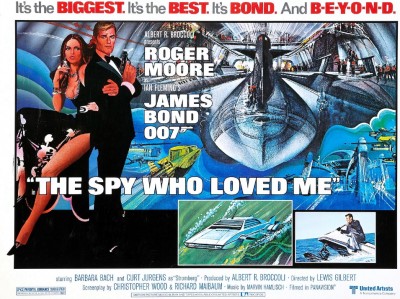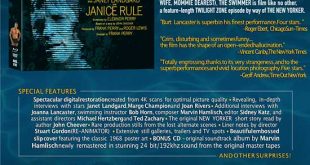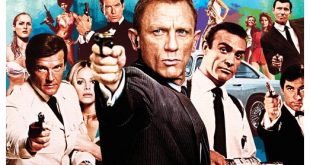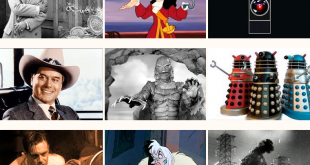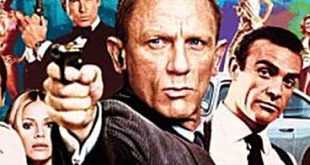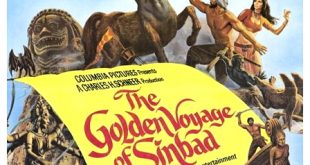 SYNOPSIS:
SYNOPSIS:
“Shipping magnate Karl Stromberg has employed two brilliant scientists to develop a submarine tracking system. Once it is finished, he assures them of multi-million-dollar payouts to their Swiss bank accounts, but not before ruthlessly murdering his young assistant by dumping her into a tank inhabited by a man-eating tiger shark. Shortly afterward, British and Soviet submarines vanish while on routine moves, and Bond is called into action. Also called to duty is his Soviet counterpart, Major Anya Amasova. Though they are initially working against each other, the British Secret Service and KGB begin to work together to find the microfilm contains the tracking system. Bond and Anya must deal with Stromberg’s goons who have been ordered to eliminate anyone who comes into contact with the microfilm. One of these is Jaws, a seven-foot-tall towering Goliath with metal teeth. When a US submarine is also hijacked, Bond and Anya must move quickly to avert World War Three, which Stromberg is hoping to start.” (courtesy IMDB)
REVIEW:
Film producer Albert R. ‘Cubby’ Broccoli revolutionised genre cinema by showing the major studios that it could actually be profitable. He thus opened the door to the multi-million-dollar financing of fantastic films, without which the genre could not have reached the dizzying heights (and abysmal depths) of today. Broccoli did this by producing a series of super-spy adventure movies starring young Sean Connery as James Bond 007, a modern-day swashbuckling killer and lover, originally the creation of bestselling author Ian Fleming. From the beginning, the Bond movies have never been hardcore fantasy, but they are the kind of fringe fantasy that was first popularised by the Doctor Mabuse films of the twenties and the Fu Manchu films of the thirties, adventures featuring super-villains and mad scientists out to control the world and an assortment of implausible scientific gadgetry. While purporting to take place in the real world, most of the Bond films are, to varying degrees, science fiction.
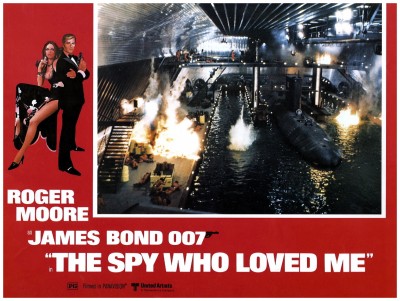 By the early seventies it seemed like the franchise had run its course. On a technical level, the last Bond film of the sixties, On Her Majesty’s Secret Service (1969), had been far superior to its immediate predecessors, with a tightly constructed plot and attempts at character development, but it didn’t do well at the box-office. The presence of Australian model-turned-actor George Lazenby in the title role probably had much to do with its relative failure but, with Diamonds Are Forever (1971), the producers returned to the reliable old formula – as much spectacle as possible and to hell with logical plot development – though their wisest move was to persuade Sean Connery to return to the role.
By the early seventies it seemed like the franchise had run its course. On a technical level, the last Bond film of the sixties, On Her Majesty’s Secret Service (1969), had been far superior to its immediate predecessors, with a tightly constructed plot and attempts at character development, but it didn’t do well at the box-office. The presence of Australian model-turned-actor George Lazenby in the title role probably had much to do with its relative failure but, with Diamonds Are Forever (1971), the producers returned to the reliable old formula – as much spectacle as possible and to hell with logical plot development – though their wisest move was to persuade Sean Connery to return to the role.
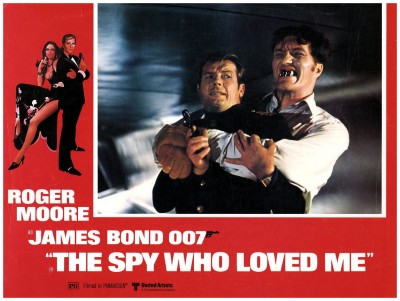 Live And Let Die (1973) starring Roger Moore directed by Guy Hamilton (who also directed Diamonds Are Forever) concentrated on stunts rather than gadgetry, but old-fashioned science fiction returned in The Man With The Golden Gun (1975) in the form of a flying car and the villain’s island headquarters containing a solar-powered laboratory and a destructive heat ray. The next film, The Spy Who Loved Me (1977), was made with the full-scale technical extravagance not seen since You Only Live Twice (1967). There are many similarities between the two films. Lewis Gilbert directed both of them, and the plots are almost identical: In You Only Live Twice the villain has a spaceship that swallows up American and Russian space vehicle in order to provoke World War Three and, in You Only Live Twice the villain has a giant supertanker that swallows up American and Russian submarines in order to provoke World War Three.
Live And Let Die (1973) starring Roger Moore directed by Guy Hamilton (who also directed Diamonds Are Forever) concentrated on stunts rather than gadgetry, but old-fashioned science fiction returned in The Man With The Golden Gun (1975) in the form of a flying car and the villain’s island headquarters containing a solar-powered laboratory and a destructive heat ray. The next film, The Spy Who Loved Me (1977), was made with the full-scale technical extravagance not seen since You Only Live Twice (1967). There are many similarities between the two films. Lewis Gilbert directed both of them, and the plots are almost identical: In You Only Live Twice the villain has a spaceship that swallows up American and Russian space vehicle in order to provoke World War Three and, in You Only Live Twice the villain has a giant supertanker that swallows up American and Russian submarines in order to provoke World War Three.
 In You Only Live Twice, Bond (Sean Connery) penetrates the villain’s headquarters in disguise, succeeds in freeing the captured Americans and Russians, there is a fierce battle and the villain’s henchmen seal themselves off within a steel shuttered control room, but Bond prevents World War Three in the nick of time by pressing a button that blows up the enemy spaceship and, in The Spy Who Loved Me, Bond (Roger Moore) penetrates the villain’s headquarters in disguise, succeeds in freeing the captured Americans and Russians, there is a fierce battle and the villain’s henchmen seal themselves off within a steel shuttered control room but, on this occasion the film comes to a halt while Bond spends time defusing an atomic missile in order to extract its high-explosive detonator. As soon as he uses it to blow up the control room, the film starts moving again and Bond prevents World War Three in the nick of time by pressing buttons causing the two enemy submarines to blow each other up, all of which goes to show how far the Bond franchise had progressed in originality during the seventies.
In You Only Live Twice, Bond (Sean Connery) penetrates the villain’s headquarters in disguise, succeeds in freeing the captured Americans and Russians, there is a fierce battle and the villain’s henchmen seal themselves off within a steel shuttered control room, but Bond prevents World War Three in the nick of time by pressing a button that blows up the enemy spaceship and, in The Spy Who Loved Me, Bond (Roger Moore) penetrates the villain’s headquarters in disguise, succeeds in freeing the captured Americans and Russians, there is a fierce battle and the villain’s henchmen seal themselves off within a steel shuttered control room but, on this occasion the film comes to a halt while Bond spends time defusing an atomic missile in order to extract its high-explosive detonator. As soon as he uses it to blow up the control room, the film starts moving again and Bond prevents World War Three in the nick of time by pressing buttons causing the two enemy submarines to blow each other up, all of which goes to show how far the Bond franchise had progressed in originality during the seventies.
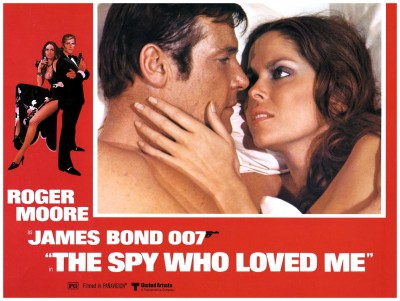 There are also set-pieces borrowed from other Bond films, such as a fight on a speeding train – already seen in both From Russia With Love (1963) and Live And Let Die (1973). British agent Bond and Russian agent Major Anya Amasova (Barbara Bach) join forces to find out who is snatching nuclear submarines from the East and West. Anya plans to murder Bond, because he had killed her boyfriend in self-defense during the opening sequence, but instead she falls in love with him. They definitely make an appealing couple, equals in every way. They have been given orders to apprehend villain Karl Stromberg (Curt Jurgens) who wants to destroy the world and rule an underwater kingdom. It’s a lot of fun, the very best of the Moore series, well-performed, smartly cast, sexy, visually impressive, lavishly produced and powerfully directed by Gilbert. Stromberg’s seven-foot-tall metal-toothed henchman ‘Jaws’ (Richard Kiel) would appear in the next Bond film, the lamentable Moonraker (1979).
There are also set-pieces borrowed from other Bond films, such as a fight on a speeding train – already seen in both From Russia With Love (1963) and Live And Let Die (1973). British agent Bond and Russian agent Major Anya Amasova (Barbara Bach) join forces to find out who is snatching nuclear submarines from the East and West. Anya plans to murder Bond, because he had killed her boyfriend in self-defense during the opening sequence, but instead she falls in love with him. They definitely make an appealing couple, equals in every way. They have been given orders to apprehend villain Karl Stromberg (Curt Jurgens) who wants to destroy the world and rule an underwater kingdom. It’s a lot of fun, the very best of the Moore series, well-performed, smartly cast, sexy, visually impressive, lavishly produced and powerfully directed by Gilbert. Stromberg’s seven-foot-tall metal-toothed henchman ‘Jaws’ (Richard Kiel) would appear in the next Bond film, the lamentable Moonraker (1979).
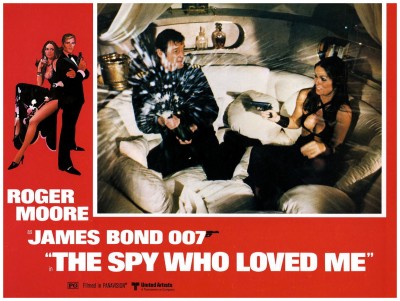 The writing of the franchise may not have improved much, but there was definitely progress made in the special effects, impressively handled by Derek Meddings. There’s an extensive use of miniatures in the film, but it’s hard to spot some of them. The villain’s headquarters, nicknamed Atlantis, is first seen rising majestically from the sea like some huge spider, the model of which was more than four metres across with tiny animatronic figures and radio-controlled helicopters taking off and landing. Meddings’ most challenging task was building and operating the giant supertanker that swallows up the submarines: “The reason we built it so large was because we had to deal with submarines in the same shots, and subs are basically just featureless tubes with conning towers stuck on top. They don’t displace the water realistically as models unless you build them to a reasonable size and even then you have to have all kinds of gadgets to disturb the water around them as they move along in order to create a realistic bow wave and wake. These devices are built into the model below the waterline.”
The writing of the franchise may not have improved much, but there was definitely progress made in the special effects, impressively handled by Derek Meddings. There’s an extensive use of miniatures in the film, but it’s hard to spot some of them. The villain’s headquarters, nicknamed Atlantis, is first seen rising majestically from the sea like some huge spider, the model of which was more than four metres across with tiny animatronic figures and radio-controlled helicopters taking off and landing. Meddings’ most challenging task was building and operating the giant supertanker that swallows up the submarines: “The reason we built it so large was because we had to deal with submarines in the same shots, and subs are basically just featureless tubes with conning towers stuck on top. They don’t displace the water realistically as models unless you build them to a reasonable size and even then you have to have all kinds of gadgets to disturb the water around them as they move along in order to create a realistic bow wave and wake. These devices are built into the model below the waterline.”
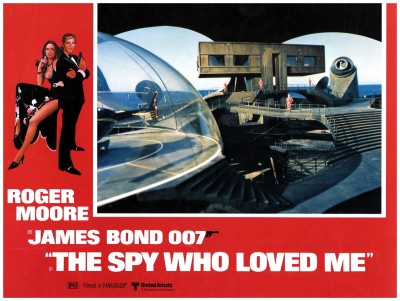 “Water is always a problem when you’re dealing with miniatures because you just can’t scale water, you’ve got to be clever enough to shoot it the right way. The American film industry has tried any amount of things to try and make the water ‘heavy’ – for want of a better word – and they’ve never succeeded. As one has to shoot water stuff at a very high speed, the secret is to make certain you don’t create a splash which is, of course, going to produce big globules of water on the screen and immediately give the game away. Even though our tanker was sixty-three feet long, it would only create a bow wave and wash that was in scale with a sixty-three-foot launch, which is nothing like what a supertanker with its vast displacement of water would create, so again we had to have water disturbers and so on all along the hull under the waterline.”
“Water is always a problem when you’re dealing with miniatures because you just can’t scale water, you’ve got to be clever enough to shoot it the right way. The American film industry has tried any amount of things to try and make the water ‘heavy’ – for want of a better word – and they’ve never succeeded. As one has to shoot water stuff at a very high speed, the secret is to make certain you don’t create a splash which is, of course, going to produce big globules of water on the screen and immediately give the game away. Even though our tanker was sixty-three feet long, it would only create a bow wave and wash that was in scale with a sixty-three-foot launch, which is nothing like what a supertanker with its vast displacement of water would create, so again we had to have water disturbers and so on all along the hull under the waterline.”
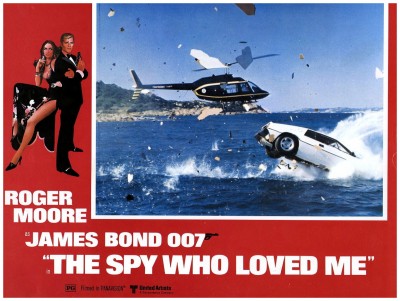 “All that tanker footage was shot in the real sea out at the Bahamas. We built the tanker at Pinewood Studios in three sections and flew it out in a cargo plane. It was put back together in Nassau. Our base was a place called Coral Harbour which had been the site for a planned luxury area with a hotel and everything, all of which was never completed and is now derelict, but they had built a number of channels leading into the sea and they proved ideal for us in launching the tanker, which weighed over twelve tons, though we had to build our own slipway. Shooting at sea is, of course, a lot more risky than filming in a studio tank, and the big problem we had with the tanker was that it wasn’t really very seaworthy, being mostly hollow in order to swallow a submarine. Only the aft section was actually built like a boat, the rest was like a catamaran built on two floats. We had a huge 175 horsepower marine engine in it which gave us a terrific wake though, of course, nothing near a real tanker’s.”
“All that tanker footage was shot in the real sea out at the Bahamas. We built the tanker at Pinewood Studios in three sections and flew it out in a cargo plane. It was put back together in Nassau. Our base was a place called Coral Harbour which had been the site for a planned luxury area with a hotel and everything, all of which was never completed and is now derelict, but they had built a number of channels leading into the sea and they proved ideal for us in launching the tanker, which weighed over twelve tons, though we had to build our own slipway. Shooting at sea is, of course, a lot more risky than filming in a studio tank, and the big problem we had with the tanker was that it wasn’t really very seaworthy, being mostly hollow in order to swallow a submarine. Only the aft section was actually built like a boat, the rest was like a catamaran built on two floats. We had a huge 175 horsepower marine engine in it which gave us a terrific wake though, of course, nothing near a real tanker’s.”
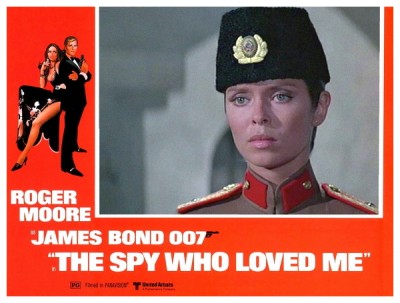 “Something went seriously wrong on the first day we took it out to sea. We’d launched it in the canal and it looked beautiful, then we started to drive it up the canal and out into the open sea. I was on a barge ahead of it and just as it was coming out of the canal I noticed that it was getting lower and lower in the water. There were three men inside, one of whom was Peter Biggs, my right-hand man, but they weren’t aware of what was happening because they had very little vision – they were looking down almost sixty feet of tanker deck and that was their only field of vision. When the bow doors were open they could look right through the tanker because we’d built a window for them, but the doors weren’t open on this occasion. We were in radio contact so I yelled over the radio, ‘Peter! You’re sinking!’ And he replied very calmly, ‘Yes, I thought we were.’ Then he flung the engine in reverse and we managed to get it back into its berth just as the front of it went underwater. We had to dive down to it, sling straps under it and pull it up with a crane. What had happened was that one of the pontoons had started to leak and two of the six pumps had packed up at the same time. But after that we never had any trouble at all.”
“Something went seriously wrong on the first day we took it out to sea. We’d launched it in the canal and it looked beautiful, then we started to drive it up the canal and out into the open sea. I was on a barge ahead of it and just as it was coming out of the canal I noticed that it was getting lower and lower in the water. There were three men inside, one of whom was Peter Biggs, my right-hand man, but they weren’t aware of what was happening because they had very little vision – they were looking down almost sixty feet of tanker deck and that was their only field of vision. When the bow doors were open they could look right through the tanker because we’d built a window for them, but the doors weren’t open on this occasion. We were in radio contact so I yelled over the radio, ‘Peter! You’re sinking!’ And he replied very calmly, ‘Yes, I thought we were.’ Then he flung the engine in reverse and we managed to get it back into its berth just as the front of it went underwater. We had to dive down to it, sling straps under it and pull it up with a crane. What had happened was that one of the pontoons had started to leak and two of the six pumps had packed up at the same time. But after that we never had any trouble at all.”
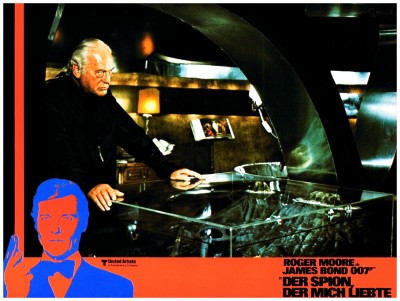 “When the tanker had to swallow a submarine, it involved careful synchronisation between the crew operating the tanker and the divers controlling the model submarine. The sub was motorised too, but manipulated by a number of divers who had to follow a set pattern of movement. It all worked very successfully, then we had to blow up the tanker for the sequences at the end of the film when there’s that big battle inside. The interior battle sequences were filmed on the huge stage at Pinewood, but there are a number of cuts showing the explosions blasting through the hull and deck of the tanker. The whole thing continues to explode until Bond and his companions escape through the bow doors in one of the subs. We had to build a model of the tanker interior for that final sequence. It was thirty feet long with every bit of detail as in the full-size one. We blew it up with a series of explosions and finally we had the catwalk which spans the interior come crashing down just as the submarine leaves the berth. We had to do all that with a model because we couldn’t bring down the catwalk in the full-size set, it would have been much too dangerous. We spent days blowing up the model tanker and then we had a controlled sinking showing it going under. It’s still there, at the bottom of the sea in the Bahamas.”
“When the tanker had to swallow a submarine, it involved careful synchronisation between the crew operating the tanker and the divers controlling the model submarine. The sub was motorised too, but manipulated by a number of divers who had to follow a set pattern of movement. It all worked very successfully, then we had to blow up the tanker for the sequences at the end of the film when there’s that big battle inside. The interior battle sequences were filmed on the huge stage at Pinewood, but there are a number of cuts showing the explosions blasting through the hull and deck of the tanker. The whole thing continues to explode until Bond and his companions escape through the bow doors in one of the subs. We had to build a model of the tanker interior for that final sequence. It was thirty feet long with every bit of detail as in the full-size one. We blew it up with a series of explosions and finally we had the catwalk which spans the interior come crashing down just as the submarine leaves the berth. We had to do all that with a model because we couldn’t bring down the catwalk in the full-size set, it would have been much too dangerous. We spent days blowing up the model tanker and then we had a controlled sinking showing it going under. It’s still there, at the bottom of the sea in the Bahamas.”
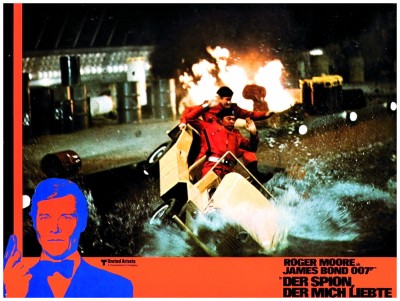 Meddings also had the job of faking a shark attack for the sequence when Stromberg disposes of a female accomplice by sending her down a chute into his shark tank (in You Only Live Twice it was a pool of piranhas). “We shot a real shark in a pool in Nassau and then used a dummy shark for the shots where it actually gets hold of the girl around the waist and shakes her. Then we built another mechanical shark back here at Pinewood for the scenes where the villain’s giant henchman ‘Jaws’ has his fight with the shark at the end of the film. Our sharks were very simple mechanisms compared to the ones in Jaws (1975). Ours ran on wires attached to trolleys, but they looked very convincing. You see it swimming around the tank in the film and it appears completely realistic. We also did all the underwater stuff involving the Lotus car that turns into a submarine. We had quite a big underwater operation at Nassau. We built a special rig to fire the car down the jetty when it was being pursued by the helicopter and it was traveling at fifty miles per hour when it left the rig.”
Meddings also had the job of faking a shark attack for the sequence when Stromberg disposes of a female accomplice by sending her down a chute into his shark tank (in You Only Live Twice it was a pool of piranhas). “We shot a real shark in a pool in Nassau and then used a dummy shark for the shots where it actually gets hold of the girl around the waist and shakes her. Then we built another mechanical shark back here at Pinewood for the scenes where the villain’s giant henchman ‘Jaws’ has his fight with the shark at the end of the film. Our sharks were very simple mechanisms compared to the ones in Jaws (1975). Ours ran on wires attached to trolleys, but they looked very convincing. You see it swimming around the tank in the film and it appears completely realistic. We also did all the underwater stuff involving the Lotus car that turns into a submarine. We had quite a big underwater operation at Nassau. We built a special rig to fire the car down the jetty when it was being pursued by the helicopter and it was traveling at fifty miles per hour when it left the rig.”
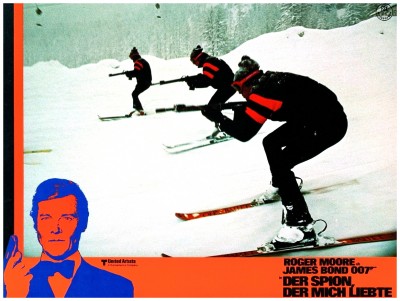 “When the film cuts to show the car sinking through the water we used a very convincing model with dummies representing Bond and the girl inside it. The change from car to submarine involved five underwater model cars with each one being used to represent a different part of the transformation process, such as the wheels retracting, the fins popping up, the motors coming out the back, etc. and there was also a full-size version that was completely drivable under water. It was full of engines and buoyancy compensators and took a two-man crew. It was quite fantastic. We also made the sequence where the rocket comes out of the back of the car, hurtles out of the water and explodes the helicopter hovering above. The copter was a radio-controlled model and, for the sequence where the Lotus sub approaches the base of Atlantis, which is like an oil rig structure, we again used models.”
“When the film cuts to show the car sinking through the water we used a very convincing model with dummies representing Bond and the girl inside it. The change from car to submarine involved five underwater model cars with each one being used to represent a different part of the transformation process, such as the wheels retracting, the fins popping up, the motors coming out the back, etc. and there was also a full-size version that was completely drivable under water. It was full of engines and buoyancy compensators and took a two-man crew. It was quite fantastic. We also made the sequence where the rocket comes out of the back of the car, hurtles out of the water and explodes the helicopter hovering above. The copter was a radio-controlled model and, for the sequence where the Lotus sub approaches the base of Atlantis, which is like an oil rig structure, we again used models.”
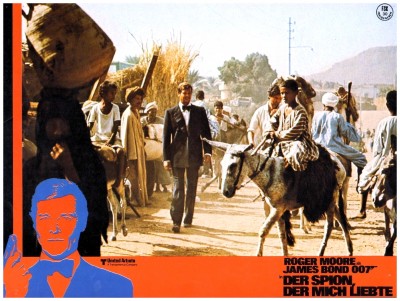 Can you imagine an alternate-universe version of The Spy Who Loved Me directed by Steven Spielberg, written by John Landis and shot by Stanley Kubrick? It could have happened! Landis was actually considered by the Broccolis as an up-and-coming writer due to his work with my old friend Roger Corman, and Spielberg was the first director considered for the job. The producers became concerned when they discovered the young filmmaker was still caught-up in the post-production schedule for a movie called Jaws (1975) which, ironically, would provide inspiration for a major character in this film. As for Kubrick’s involvement, the story goes like this: The eyesight of cinematographer Claude Renoir was failing at the time and he had a great deal of difficulty lighting the vast supertanker set with its reflective surfaces and deep dark corners. Set designer Ken Adam turned to his friend Kubrick who, under conditions of complete secrecy, supervised the lighting. Furthermore, his stepdaughter Katharina Kubrick supposedly designed Richard Kiel‘s metallic dentures!
Can you imagine an alternate-universe version of The Spy Who Loved Me directed by Steven Spielberg, written by John Landis and shot by Stanley Kubrick? It could have happened! Landis was actually considered by the Broccolis as an up-and-coming writer due to his work with my old friend Roger Corman, and Spielberg was the first director considered for the job. The producers became concerned when they discovered the young filmmaker was still caught-up in the post-production schedule for a movie called Jaws (1975) which, ironically, would provide inspiration for a major character in this film. As for Kubrick’s involvement, the story goes like this: The eyesight of cinematographer Claude Renoir was failing at the time and he had a great deal of difficulty lighting the vast supertanker set with its reflective surfaces and deep dark corners. Set designer Ken Adam turned to his friend Kubrick who, under conditions of complete secrecy, supervised the lighting. Furthermore, his stepdaughter Katharina Kubrick supposedly designed Richard Kiel‘s metallic dentures!
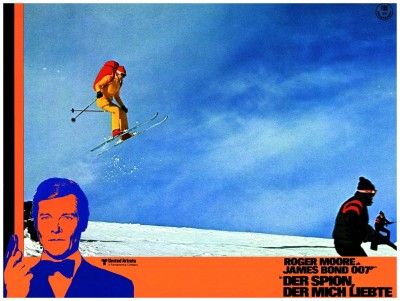 The cast – both regulars and newcomers – is uniformly above-average with Roger Moore at his very best, even though he’s almost two decades older than when he was first picked for the role of Bond in Doctor No (1962). I’ll explain. Broccoli first wanted Patrick McGoohan for the role, but he was contracted to the Dangerman/Secret Agent television series. Next on his wish list was Moore, but he was contracted to The Saint television series, so Broccoli had to settle for the relatively unknown Sean Connery. Barbara Bach and Richard Kiel went on to appear together in both Force Ten From Navarone (1978) and The Humanoid (1979). Sexy Hammer Horror Scream Queen Caroline Munro turned down the part of Ursa in Superman The Movie (1978) in order to play the relatively small role of Naomi in The Spy Who Loved Me. Just before shooting her scenes, the unfortunate actress sat on a bee and was stung badly. Despite the pain, she was pushed on to complete the scenes, so the resulting stern look on her face wasn’t entirely due to good acting.
The cast – both regulars and newcomers – is uniformly above-average with Roger Moore at his very best, even though he’s almost two decades older than when he was first picked for the role of Bond in Doctor No (1962). I’ll explain. Broccoli first wanted Patrick McGoohan for the role, but he was contracted to the Dangerman/Secret Agent television series. Next on his wish list was Moore, but he was contracted to The Saint television series, so Broccoli had to settle for the relatively unknown Sean Connery. Barbara Bach and Richard Kiel went on to appear together in both Force Ten From Navarone (1978) and The Humanoid (1979). Sexy Hammer Horror Scream Queen Caroline Munro turned down the part of Ursa in Superman The Movie (1978) in order to play the relatively small role of Naomi in The Spy Who Loved Me. Just before shooting her scenes, the unfortunate actress sat on a bee and was stung badly. Despite the pain, she was pushed on to complete the scenes, so the resulting stern look on her face wasn’t entirely due to good acting.
 Character actor Shane Rimmer, as the American submarine captain, makes his third appearance in a Bond movie, after You Only Live Twice (1967) and Diamonds Are Forever (1971), as well as providing the voice for the American agent at the beginning of Live And Let Die (1973). One of a select group of British actors with authentic American accents (including Ed Bishop, and later Matt Frewer, William Hootkins and Mac McDonald), Rimmer can be seen (or heard) in virtually every Gerry Anderson production ever, and almost every American superhero film shot at Pinewood Studios, from Superman The Movie (1978) to Batman Begins (2005). Unfortunately, regular Bond composer John Barry was unable to return to the UK at that time due to tax problems, and couldn’t compose the score for this movie, so The Spy Who Loved Me became the first Bond film to be composed by an American, Marvin Hamlisch, who also wrote the title song Nobody Does It Better, supposedly inspired by a Mozart piece. Performed by Carly Simon, it was also the first Bond song not to have the same title as the film, although the phrase ‘The Spy Who Loved Me’ is included in the lyrics. Nominated for an Oscar that year, the song was so successful that the title has since become part of Bond universe phraseology.
Character actor Shane Rimmer, as the American submarine captain, makes his third appearance in a Bond movie, after You Only Live Twice (1967) and Diamonds Are Forever (1971), as well as providing the voice for the American agent at the beginning of Live And Let Die (1973). One of a select group of British actors with authentic American accents (including Ed Bishop, and later Matt Frewer, William Hootkins and Mac McDonald), Rimmer can be seen (or heard) in virtually every Gerry Anderson production ever, and almost every American superhero film shot at Pinewood Studios, from Superman The Movie (1978) to Batman Begins (2005). Unfortunately, regular Bond composer John Barry was unable to return to the UK at that time due to tax problems, and couldn’t compose the score for this movie, so The Spy Who Loved Me became the first Bond film to be composed by an American, Marvin Hamlisch, who also wrote the title song Nobody Does It Better, supposedly inspired by a Mozart piece. Performed by Carly Simon, it was also the first Bond song not to have the same title as the film, although the phrase ‘The Spy Who Loved Me’ is included in the lyrics. Nominated for an Oscar that year, the song was so successful that the title has since become part of Bond universe phraseology.
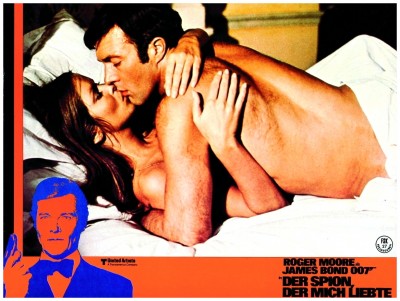 During the making of You Only Live Twice (1967) Pinewood Studios was dominated by a huge structure built to contain the set representing the interior of the villain’s artificial volcano, and similarly in 1976 a vast stage shaped like an dirigible hangar rose on the backlot to house the set representing the interior of the supertanker. Both structures were created by production designer Ken Adam but, whereas the artificial volcano had to be torn down due to protests from local residents, the new Bond building, officially named the ‘007 Stage’, remained a permanent fixture at Pinewood, a monument to both Adam’s grandiose vision and to the Bond phenomenon in general. The 007 Stage burned down in June 1984 while filming Ridley Scott‘s Legend (1985), but it was soon rebuilt, reopened and renamed ‘The Albert R. Broccoli 007 Stage’ just in time to start shooting A View To A Kill (1985).
During the making of You Only Live Twice (1967) Pinewood Studios was dominated by a huge structure built to contain the set representing the interior of the villain’s artificial volcano, and similarly in 1976 a vast stage shaped like an dirigible hangar rose on the backlot to house the set representing the interior of the supertanker. Both structures were created by production designer Ken Adam but, whereas the artificial volcano had to be torn down due to protests from local residents, the new Bond building, officially named the ‘007 Stage’, remained a permanent fixture at Pinewood, a monument to both Adam’s grandiose vision and to the Bond phenomenon in general. The 007 Stage burned down in June 1984 while filming Ridley Scott‘s Legend (1985), but it was soon rebuilt, reopened and renamed ‘The Albert R. Broccoli 007 Stage’ just in time to start shooting A View To A Kill (1985).
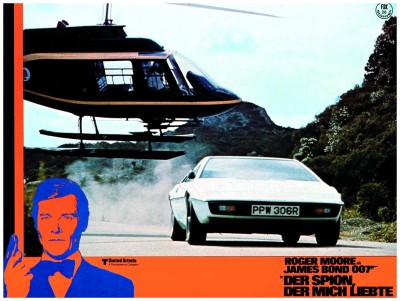 Cubby Broccoli knew he was onto something when he decided to dedicate his career to the Bond franchise. When Doctor No (1962) was released, no-one could have guessed that, like The Rolling Stones and The Queen, 007 would still be going strong as a family business, fifty years plus and more than twelve billion dollars later. It’s at this point I’ll take my leave of you, but not before profusely thanking John Brosnan and Tony Crawley, authors of James Bond For Your 007 Eyes Only (published 1981) for assisting my research for this article, not to mention the producers and distributors of the James Bond DVDs, all of which are chock-a-block full of informative documentaries, entertaining interviews and more behind-the-scenes featurettes than you could poke a stick at…if that’s really what you want to do. And it’s with that sado-masochistic thought in mind I’ll ask you to please join me again next week when I have another opportunity to give your cinematic sensibilities a damn good thrashing with the ugly stick for…Horror News! Toodles!
Cubby Broccoli knew he was onto something when he decided to dedicate his career to the Bond franchise. When Doctor No (1962) was released, no-one could have guessed that, like The Rolling Stones and The Queen, 007 would still be going strong as a family business, fifty years plus and more than twelve billion dollars later. It’s at this point I’ll take my leave of you, but not before profusely thanking John Brosnan and Tony Crawley, authors of James Bond For Your 007 Eyes Only (published 1981) for assisting my research for this article, not to mention the producers and distributors of the James Bond DVDs, all of which are chock-a-block full of informative documentaries, entertaining interviews and more behind-the-scenes featurettes than you could poke a stick at…if that’s really what you want to do. And it’s with that sado-masochistic thought in mind I’ll ask you to please join me again next week when I have another opportunity to give your cinematic sensibilities a damn good thrashing with the ugly stick for…Horror News! Toodles!
 Horror News | HNN Official Site | Horror Movies,Trailers, Reviews
Horror News | HNN Official Site | Horror Movies,Trailers, Reviews
